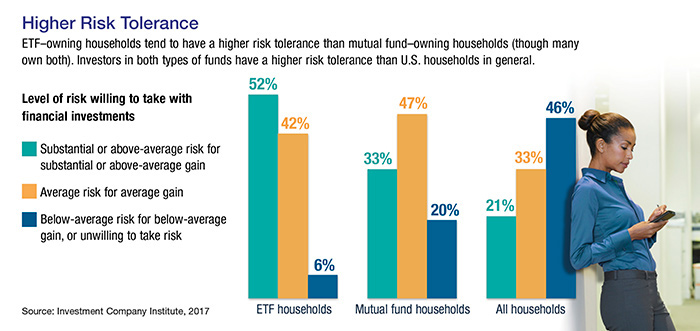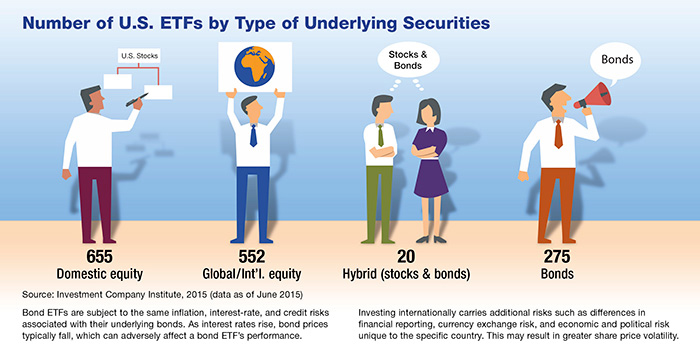What Is an Exchange-Traded Fund?
Exchange-traded funds (ETFs) are just one of the many types of investment funds available, but they have some qualities that are unique and set them apart from other vehicles. ETFs are securities that attempt to track all types of indexes, industries, or commodities. For example, an ETF might be made up of securities representative of the technological industry or of the S&P 500.* Click here to read more
ETFs on the Rise
Mutual funds are still king of the investment world, but investor interest in exchange-traded funds (ETFs) has grown quickly over the last decade. At the end of 2017, more than $3.4 trillion in assets were invested among over 1,800 ETFs. This is equivalent to about 18% of the assets invested in mutual funds. In 2007, ETF assets were equivalent to only about 5% of mutual fund assets.1
Why the increased interest? ETFs have some attractive features that set them apart from mutual funds. But there are also cost and risk factors to consider.
Trading Flexibility
Like a mutual fund, an ETF is a portfolio of securities assembled by an investment company. Mutual funds are typically purchased from and sold back to the investment company and priced at the end of the trading day, with the price determined by the net asset value (NAV) of the underlying securities. By contrast, ETFs can be traded throughout the day on stock exchanges, like individual stocks, and the price may be higher or lower than the NAV because of supply and demand.
In relatively calm markets, ETF prices and net asset values are generally close. However, when financial markets become more volatile, ETFs may quickly reflect changes in market sentiment, while net asset values — adjusted once a day — may take longer to react, resulting in ETFs trading at a premium or discount.
Most ETFs are passively managed and track an index of securities. Investors can choose from a variety of indexes, ranging from broad-based stock or bond indexes to very specific market sectors. A growing number of actively managed ETFs assemble a non-indexed mix of investments that should reflect the fund’s objectives. Because ETFs are available across a broad range of indexes and investment objectives, they can help provide a level of diversification.

Expenses and Risks
ETFs typically have lower expense ratios than mutual funds. However, you must pay a brokerage commission when you buy or sell ETFs, so your overall costs may be higher, especially if you trade frequently. The trading flexibility of ETFs is part of their appeal, but it could lead some investors to trade more frequently than might be appropriate for their situations. Also, whereas mutual fund assets can typically be exchanged within a fund family at the end of the trading day, moving assets between ETFs requires selling and buying assets separately.
Diversification is a method used to help manage investment risk; it does not guarantee a profit or protect against investment loss. The principal value of ETFs and mutual funds fluctuates with market conditions. Shares, when sold, may be worth more or less than their original cost.
Exchange-traded funds and mutual funds are sold by prospectus. Please consider the investment objectives, risks, charges, and expenses carefully before investing. The prospectus, which contains this and other information about the investment company, can be obtained from your financial professional. Be sure to read the prospectus carefully before deciding whether to invest.
1) Investment Company Institute, 2017–2018
This information is not intended as tax, legal, investment, or retirement advice or recommendations, and it may not be relied on for the purpose of avoiding any federal tax penalties. You are encouraged to seek advice from an independent professional advisor. The content is derived from sources believed to be accurate. Neither the information presented nor any opinion expressed constitutes a solicitation for the purchase or sale of any security. This material was written and prepared by Broadridge Advisor Solutions. © 2018 Broadridge Investor Communication Solutions, Inc.
The Appeal of ETFs
Exchange-traded funds (ETFs) represented 28% of the total trading value on world stock exchanges at the end of June 2015, a 35% increase over the previous year.1 In the United States, 1,502 ETFs held more than $2 trillion in assets at mid-year, up more than 10% and 13%, respectively, over the same period in 2014.2
Why the increased interest in ETFs? The primary factors may be trading flexibility and relatively low costs.

Built Like Mutual Funds, Traded Like Stocks
An ETF is a portfolio of securities assembled by an investment company, similar to a mutual fund. Yet these two types of funds are traded very differently.
Mutual funds are typically purchased from and sold back to the investment company and priced at the end of the trading day, with the price determined by the value of the underlying securities. By contrast, ETFs can be traded throughout the day on stock exchanges, like individual stocks, and the price may be higher or lower than the value of the underlying securities because of supply and demand.
The trading flexibility of ETFs is part of their appeal, but it might lead some investors to trade more frequently than may be appropriate for their situations. And while you can usually trade between two mutual funds in the same fund family directly at the end of the trading day, if you want to move assets between two ETFs (without using additional funds), you have to sell the first ETF and then purchase the new ETF.
ETFs typically have lower expense ratios than mutual funds, but you must pay a brokerage commission whenever you buy or sell ETFs, so your overall costs could be higher, especially if you trade frequently. Most ETFs are passively managed and track an index of securities, which helps keep fees low. However, a growing number of actively managed ETFs assemble a specific mix of investments reflecting the fund’s objectives. They may have higher fees than passively managed funds.
Because ETFs are available across a broad range of indexes, they can help provide cost-efficient diversification. As with any investment, consider the potential risks before making a decision to include ETFs in your portfolio. Diversification is a method used to help manage investment risk; it does not guarantee a profit or protect against investment loss.
The principal value of mutual funds and ETFs fluctuates with market conditions. Shares, when sold, may be worth more or less than their original cost.
For more information or to attend one of our workshop please click here
Exchange-traded funds and mutual funds are sold by prospectus. Please consider the investment objectives, risks, charges, and expenses carefully before investing. The prospectus, which contains this and other information about the investment company, can be obtained from your financial professional. Be sure to read the prospectus carefully before deciding whether to invest.
1) CNBC.com, July 2, 2015
2) Investment Company Institute, 2015
The information in this article is not intended as tax or legal advice, and it may not be relied on for the purpose of avoiding any federal tax penalties. You are encouraged to seek tax or legal advice from an independent professional advisor. The content is derived from sources believed to be accurate. Neither the information presented nor any opinion expressed constitutes a solicitation for the purchase or sale of any security. This material was written and prepared by Emerald. Copyright 2016 Emerald Connect, LLC.

